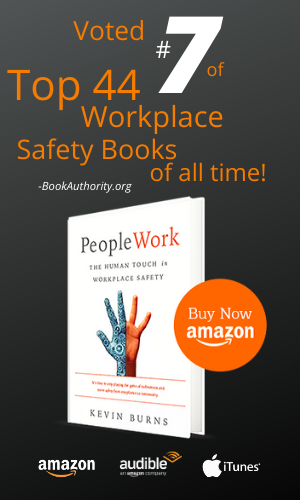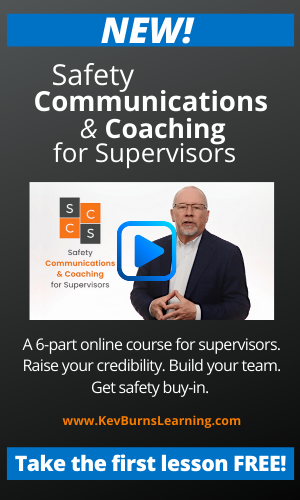The Competition Between Production and Safety
Twenty years ago, most of the safety jobs that exist today, weren’t around. In another ten years, most of the safety jobs as you know them will have disappeared. New ideas make way for new approaches. And for anyone who thinks that safety will be the same in ten years from now is not paying attention. Everything cycles, including safety.
Companies are already realigning how they do safety, how they integrate safety into everything they do and every person they hire. And companies are starting to question why, if safety is everyone’s responsibility, why do they need so many safety people on the ground? The better that companies train their supervisors and their front-line employees, the more likely that safety will simply become integrated with every part of the organization. And the need for advisors waiting to be asked a question will likely disappear. As it should.
If you'd like to become a better supervisor, communicator and coach, then start by taking the Free Preview of the Safety Communications & Coaching for Supervisors course. 40-minutes of video instruction, summary sheet download PDFs and a companion MP3 audio version to take with you on the go. And it's free to get started.
There is a mindset competition.
My book, PeopleWork : The Human Touch in Workplace Safety had been purchased by a company for every senior-level manager and VP to read. After reading his copy, the CEO had invited me to spend some time with him and several executives in his office. He expressed that the thing that he wanted to fix most of all was the perceived competition between production and safety. Their safety program was already exceptional having won awards for their safety performance, but he wanted to push for more improvement.
Employees’ mental competition between safety and production has more to do with how safety has been positioned rather than an actual competition between two departments. Simply put, if the operations department and the safety department are not the same, there will be competition. If the VP Operations and VP Safety are not the same person, there is going to be a competition. And even calling them “safety” procedures implies that there is one way of doing the task and then there is the safety way – as if they are not the same way. And as long as one is called “safety” they are not the same. They will compete for mind space.
And as long as one is called “safety” they are not the same. They will compete for mind space.
But it isn’t just production and safety where the competition exists. If there is a push on for production, then HR’s scheduled Sensitivity Training and Bullying seminar will get re-scheduled. That piece of equipment that is due to be taken out of service for maintenance will be re-scheduled to once the production deadline has expired. That social staff event may have to wait a bit.
Except there is no competition.
 You have created the very competition that you want to overcome. You call them safety meetings when they’re just meetings. You call them safety manuals when they’re just manuals. You call them safety procedures when they’re the only right way of doing the job. You feel like you have to fight with your people to get them to do things the safe way when it should be the only way that is acceptable.
You have created the very competition that you want to overcome. You call them safety meetings when they’re just meetings. You call them safety manuals when they’re just manuals. You call them safety procedures when they’re the only right way of doing the job. You feel like you have to fight with your people to get them to do things the safe way when it should be the only way that is acceptable.
You eliminate the mental competition when you stop referring to processes and departments by putting the word “safety” in front of it. Even Safety Advisors are simply advisors on how to do the job properly. And anyone who tries to accomplish a task outside of the proper procedure runs the risk of being ostracized in their own workplace. Anything outside of the right way is wrong. Period.
The alternative.
The Safety department needs to come together with Operations and form the Safe Operations department. I purposely put the word "safe" in front of operations as an illustrative point that both departments need to be working toward the same end, under the same roof, for the betterment of people and production. There needs to be full interaction daily between these two parts of the organization so that each can advise the other. The Safe Operations department would focus on making all processes and procedures work in favour of looking after employees. To help them become more efficient by doing the job only once and by learning better ways to slow down and make every step count. No push for production would occur without ensuring that full protection and safety of employees remains the top concern.
If you’re still having to discipline your people for their “safety” infractions, you’re lagging.
As for the argument that safety departments need to be separate from Operations in case they have to discipline someone, well that train has left the station. If you’re still having to discipline your people for their “safety” infractions, you’re lagging. Discipling your front-line people for safety infractions doesn’t solve your glaringly obvious supervisory, management, training, hiring and process problems that are eating away at employee engagement, motivation and morale. Besides, you can’t scold someone into safety.
-- Take the FREE preview lesson of Kevin's course Safety Communications & Coaching for Supervisors. 40-minutes of video instruction, summary download PDFs and a companion audio MP3 version to take with you on the go. SCCS is an online course to help energize safety, build teamwork, and get employee buy-in.
Take the FREE preview lesson of Kevin's course Safety Communications & Coaching for Supervisors. 40-minutes of video instruction, summary download PDFs and a companion audio MP3 version to take with you on the go. SCCS is an online course to help energize safety, build teamwork, and get employee buy-in.
Kevin Burns, consultant/author, works with smart, caring companies to energize safety culture, build teamwork, and get employee buy-in.
KevBurns Learning is committed to to helping companies improve safety by improving people, through creative learning materials, virtual strategy sessions, safety meeting presentations, and team coaching programs.
In 2020, BookAuthority.org named PeopleWork #7 of The Top 44 Workplace Safety Books of All Time. Buy yourself a copy of PeopleWork: The Human Touch in Workplace Safety and give another as a gift to a colleague.
Subscribe to Kevin's YouTube channel.
Subscribe to Kevin’s Blog.


